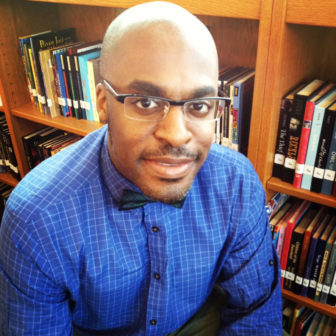The Boys and Girls Clubs of America, on a grant from The Wallace Foundation, is running a pilot project with six of its Midwestern clubs to see if a large, generalist organization can use principles from a 2013 study to set up arts programs.
It’s part of an ongoing foundation initiative to deliver such high-quality programs to low-income urban tweens in an after-school setting.
“Raising the Barre and Stretching the Canvas” is the evaluation of the project.

Devan Blackwell
OST Hub editor Sara Hill interviewed Devan Blackwell, education program development specialist, about the project and the report. Blackwell is a consultant at Spatialosophy. He has designed, developed and otherwise worked with learning opportunities that support the academic, artistic and social-emotional development of students for more than 15 years. He was a fellow of the National Afterschool Matters Fellowship from 2015 to 2017.
Q: What were your general impressions of the project and the report?
A: I found it relevant and useful to my work. The study showed that with an infusion of funding any general after-school program can achieve a high-quality arts program. It means bringing in professional artists to work with youth, providing opportunities for kids’ exposure to the arts and creating physical and emotional spaces for creativity. The clubs were also able to create intentionally designed art studio spaces used only for the function of the project.
Q:. Did the challenges mentioned in the report sound familiar?
A: Yes, and I liked how the report was honest about the challenges — how to cultivate relationships, how program staff work with artists, if there’s a strong program culture, how can they co-exist. I wondered how many facilities have extra space that can be repurposed, specifically for use as an art space.
Doing this in a school setting would be most challenging, as there can be issues around lack of available space and more commonly, of territoriality. I was visiting a program in a school with the same student participants, and at 3:01 they become those “after-school kids.” Teachers leave sticky notes to the after-school staff such as, “Don’t touch this and that.” In some cases, administration doesn’t allow space in the school to display after-school club student art work.
Another challenge that resonates with me was the idea of how some teaching artists might lack the cultural competencies and a youth development background. Often their tenure is not very long. They go to inner-city schools, and don’t stay. I’ve been going to a school where there’s a professional dancer giving lessons, and because of the kids’ behaviors, and his lack of classroom management skills, he needs a lot of additional support from the after-school staff. That’s expensive. It comes down to, can we afford him, or should we put the money in developing our staff? It becomes the generalists versus the specialists.
Q: What are some questions that remain for you?
A: Selective participation, when you select which kids will participate, it inevitably keeps certain kids away from opportunities. But what if the kids who are acting out the most need art the most? Participating might be transformational for them.
The report also brings up questions about professionalizing the field: How do we provide opportunities for youth workers to grow? One idea I had was when hiring a youth worker, ask them questions to find out their passion or area of interest. A school custodian who is a photographer, for example. Who else on staff or in the facility has an interest in STEM or art? Maybe they’ll buy in more because it’s a passion project. It’s about cultivating the talent already exists.
I recently met a youth worker at a Boys and Girls Club who carries a notebook with pages and pages of writing about ideas for what to do with his kids such as: “list five of your favorite songs” and “create a rap about your neighborhood.” He thought he was creating busywork for youth. He didn’t know that they were really lesson plans. I asked him, “Do you know that these are what teachers create when they plan their classroom lessons?” And he had no idea.
It would be ideal to match staff like that with visiting artists who might be mentors for them. It would be mutually beneficial, each would be learning something from the other. The youth worker would be able to teach the artist about the community and how to interact with the kids. Just as the artist is exposing kids to the arts, the artists are getting exposed to a different reality or perspective. It would help the artist to develop their cultural competency.
I loved the idea in the project of providing the “try it” week for the kids. Maybe they could offer the same thing to the youth staff. Like an apprenticeship. So when the artist leaves, there would be someone left on-site who has knowledge about the project and can replicate, to some degree, the work.






























